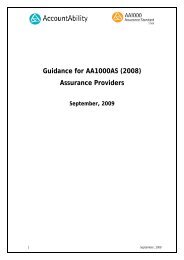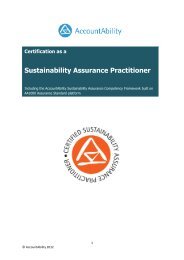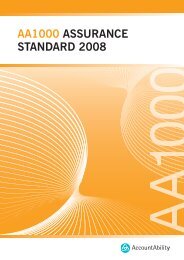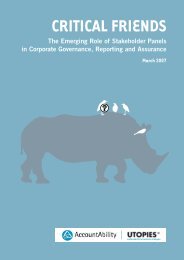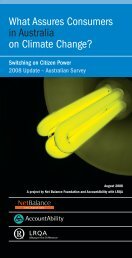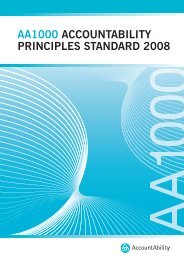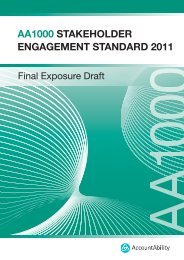The Stakeholder Engagement Manual Volume 2 - AccountAbility
The Stakeholder Engagement Manual Volume 2 - AccountAbility
The Stakeholder Engagement Manual Volume 2 - AccountAbility
Create successful ePaper yourself
Turn your PDF publications into a flip-book with our unique Google optimized e-Paper software.
Annex<br />
JARGON BUSTER<br />
JARGON BUSTER<br />
Accountability<br />
An organisation can be considered as accountable when it accounts to its<br />
stakeholders regarding material issues (transparency), responds to stakeholders<br />
regarding these issues (responsiveness) on an ongoing basis, and complies with<br />
standards to which it is voluntarily committed, and with rules and regulations<br />
that it must comply with for statutory reasons (compliance).<br />
Communication<br />
Any manner of information-sharing with stakeholders, generally through oneway,<br />
non-iterative processes.<br />
Consultation<br />
Th e process of gathering information or advice from stakeholders and taking<br />
those views into consideration to amend plans, make decisions or set directions.<br />
Corporate Social Responsibility (CSR)<br />
A concept whereby companies integrate social and environmental concerns in<br />
their business operations and in their interaction with their stakeholders. Other<br />
terms used to refer to the same concept include CESR (corporate environmental<br />
and social responsibility), corporate citizenship and corporate responsibility.<br />
Dialogue<br />
An exchange of views and opinion to explore diff erent perspectives, needs and<br />
alternatives, with a view to fostering mutual understanding, trust and cooperation<br />
on a strategy or initiative.<br />
<strong>Engagement</strong><br />
An organisation’s eff orts to understand and involve stakeholders and their<br />
concerns in its activities and decision-making processes.<br />
Margins of Movement<br />
<strong>The</strong> boundaries which defi ne what an organisation can and cannot do in<br />
order to address an issue and the related stakeholders’ expectations. Margins of<br />
movement are determined by the resources an organisation has for addressing an<br />
issue, and by organisational objectives which are not changeable but in confl ict<br />
with potential ways of addressing an issue that stakeholders might expect.<br />
THE PRACTITIONER'S HANDBOOK ON STAKEHOLDER ENGAGEMENT | 135



